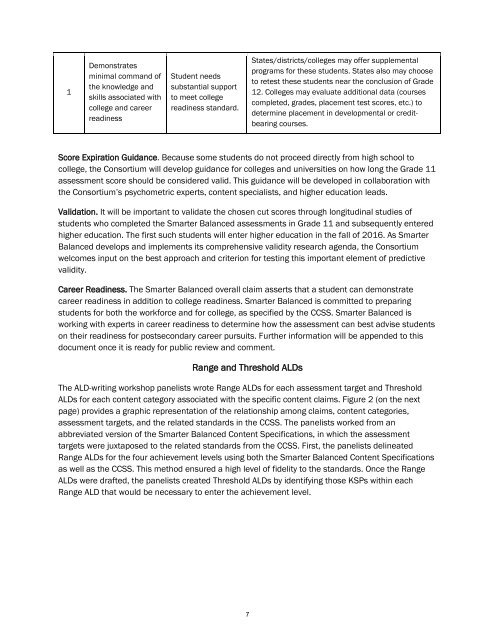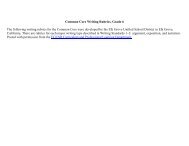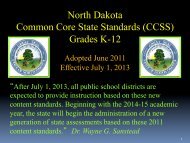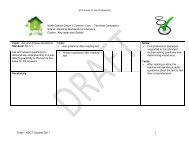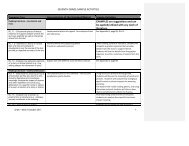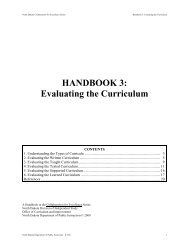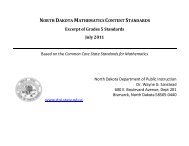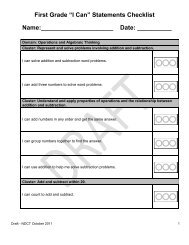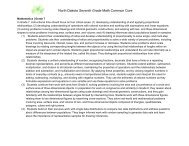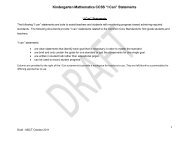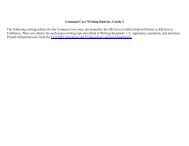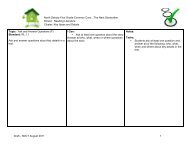SBAC Achievement Level Descriptors, Grade 4 - ND Curriculum ...
SBAC Achievement Level Descriptors, Grade 4 - ND Curriculum ...
SBAC Achievement Level Descriptors, Grade 4 - ND Curriculum ...
Create successful ePaper yourself
Turn your PDF publications into a flip-book with our unique Google optimized e-Paper software.
1Demonstratesminimal command ofthe knowledge andskills associated withcollege and careerreadinessStudent needssubstantial supportto meet collegereadiness standard.States/districts/colleges may offer supplementalprograms for these students. States also may chooseto retest these students near the conclusion of <strong>Grade</strong>12. Colleges may evaluate additional data (coursescompleted, grades, placement test scores, etc.) todetermine placement in developmental or creditbearingcourses.Score Expiration Guidance. Because some students do not proceed directly from high school tocollege, the Consortium will develop guidance for colleges and universities on how long the <strong>Grade</strong> 11assessment score should be considered valid. This guidance will be developed in collaboration withthe Consortium’s psychometric experts, content specialists, and higher education leads.Validation. It will be important to validate the chosen cut scores through longitudinal studies ofstudents who completed the Smarter Balanced assessments in <strong>Grade</strong> 11 and subsequently enteredhigher education. The first such students will enter higher education in the fall of 2016. As SmarterBalanced develops and implements its comprehensive validity research agenda, the Consortiumwelcomes input on the best approach and criterion for testing this important element of predictivevalidity.Career Readiness. The Smarter Balanced overall claim asserts that a student can demonstratecareer readiness in addition to college readiness. Smarter Balanced is committed to preparingstudents for both the workforce and for college, as specified by the CCSS. Smarter Balanced isworking with experts in career readiness to determine how the assessment can best advise studentson their readiness for postsecondary career pursuits. Further information will be appended to thisdocument once it is ready for public review and comment.Range and Threshold ALDsThe ALD-writing workshop panelists wrote Range ALDs for each assessment target and ThresholdALDs for each content category associated with the specific content claims. Figure 2 (on the nextpage) provides a graphic representation of the relationship among claims, content categories,assessment targets, and the related standards in the CCSS. The panelists worked from anabbreviated version of the Smarter Balanced Content Specifications, in which the assessmenttargets were juxtaposed to the related standards from the CCSS. First, the panelists delineatedRange ALDs for the four achievement levels using both the Smarter Balanced Content Specificationsas well as the CCSS. This method ensured a high level of fidelity to the standards. Once the RangeALDs were drafted, the panelists created Threshold ALDs by identifying those KSPs within eachRange ALD that would be necessary to enter the achievement level.7


